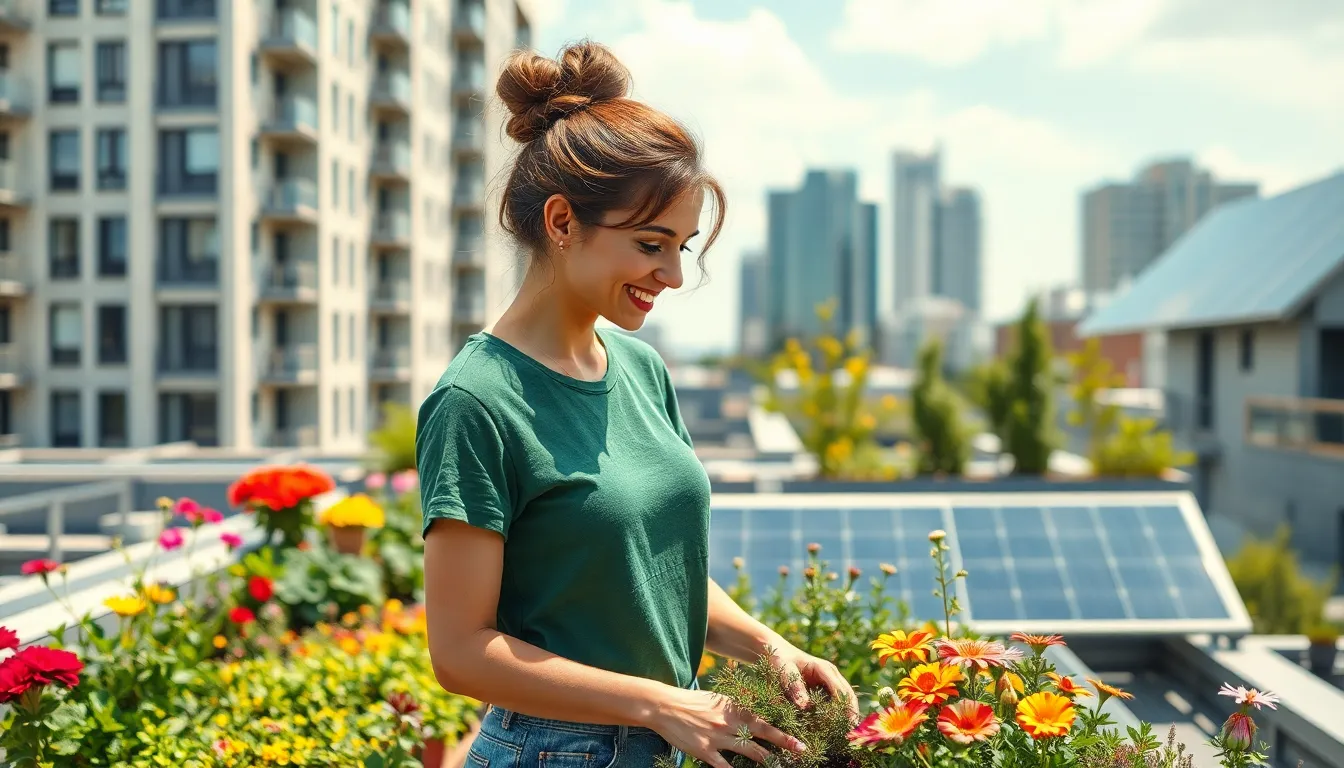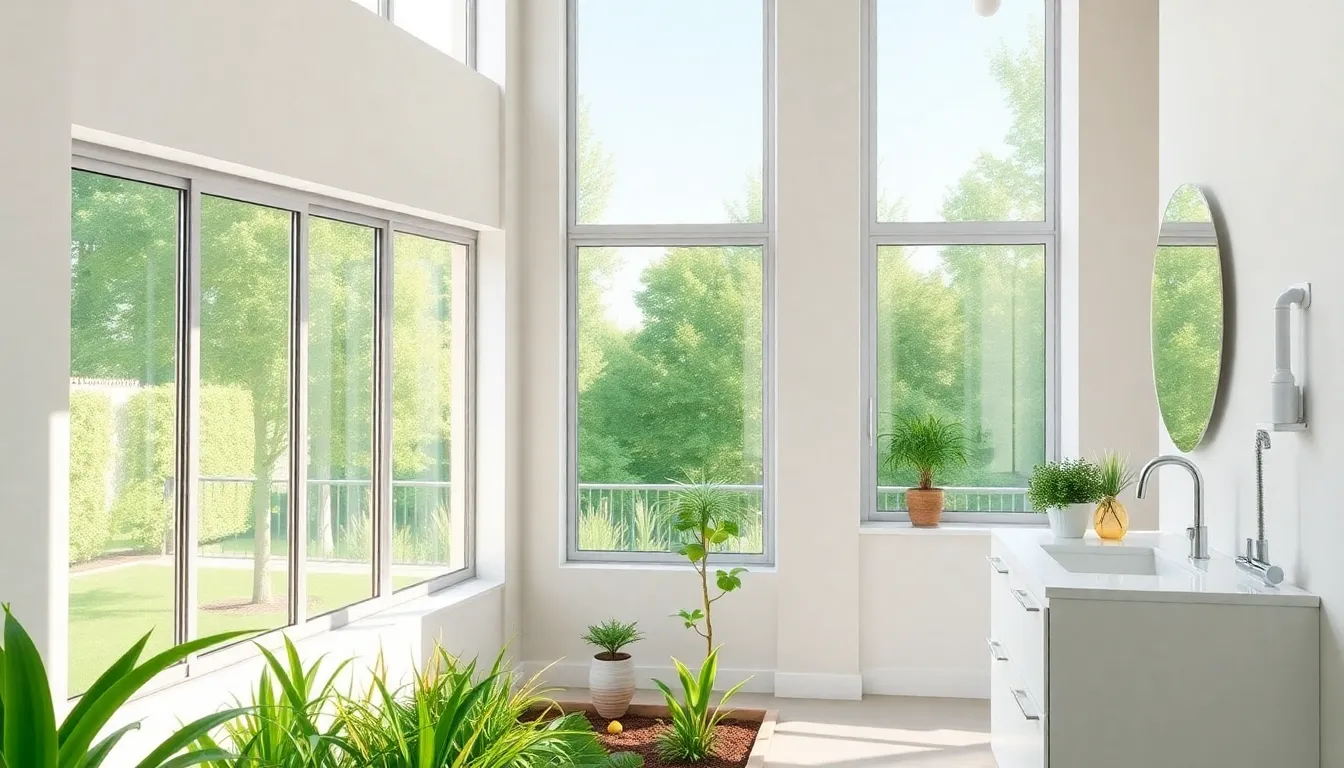Phone:
(701)814-6992
Physical address:
6296 Donnelly Plaza
Ratkeville, Bahamas.

In a world where the planet seems to be giving us the side-eye, sustainable apartment living is like that eco-friendly superhero we didn’t know we needed. Imagine sipping your morning coffee while knowing you’re saving the Earth, one recycled bottle at a time. It’s not just about living in a shoebox; it’s about turning that shoebox into a cozy, green haven that even Mother Nature would approve of.
Sustainable living isn’t just a trend; it’s a lifestyle choice that’s both stylish and responsible. From energy-efficient appliances to rooftop gardens, modern apartments are transforming into eco-friendly retreats. So why not join the movement? Embrace a lifestyle that’s not only good for your wallet but also for the planet. After all, who wouldn’t want to brag about their eco-chic home at the next dinner party? Let’s dive into the world of sustainable apartment living and discover how to make a difference without sacrificing comfort or style.
Sustainable apartment living plays a crucial role in reducing individual environmental footprints. This lifestyle choice directly contributes to energy conservation and waste reduction. Eco-friendly features enhance not only the functionality but also the aesthetic appeal of living spaces. Integrating energy-efficient appliances minimizes electricity usage, ultimately lowering utility bills.
Green building materials for renovations or new constructions reduce environmental impact significantly. Rooftop gardens and community green spaces not only improve air quality but also foster biodiversity. Access to public transportation and biking facilities encourages responsible commuting practices. This shift towards sustainable options creates a healthier living environment for everyone.
Statistics reveal that buildings account for approximately 39% of carbon emissions in the United States. Adopting sustainable practices can significantly mitigate these emissions while supporting cleaner air initiatives. Apartment residents can benefit from implementing waste separation systems, which enhance recycling efforts within the community.
Moreover, sustainable living often increases property value, making it an attractive option for both renters and owners. Improved water management systems can decrease consumption and promote conservation efforts. Prioritizing sustainable features during the apartment search aligns personal values with the broader goal of environmental stewardship.
Overall, the importance of sustainable apartment living resonates with modern society’s increasing awareness of ecological issues. Embracing these practices not only protects the planet but also enhances quality of life.

Sustainable apartment living hinges on principles that prioritize environmental health and personal comfort. By making mindful choices, residents can create eco-friendly homes.
Energy efficiency remains a cornerstone of sustainable living. Utilizing Energy Star-rated appliances reduces energy consumption significantly. Natural lighting enhances indoor spaces, minimizing reliance on artificial lights. Insulating windows and doors prevents heat loss, leading to lower heating costs. Smart thermostats offer convenience, adjusting temperatures automatically based on occupancy patterns. Small changes, like using LED bulbs, contribute to substantial energy savings. Overall, residents lower their carbon footprints while enjoying reduced utility bills.
Water conservation plays a vital role in sustainable apartment living. Installing low-flow fixtures decreases water usage without sacrificing performance. Collecting rainwater for irrigation supports outdoor greenery and reduces reliance on municipal supplies. Regular maintenance of plumbing systems prevents leaks, which can waste thousands of gallons annually. Choosing native plants for landscaping decreases water needs while enhancing aesthetic appeal. Efficient practices, like scheduled watering, ensure minimal water loss. Such strategies promote responsible water usage, aligning personal habits with prevailing environmental goals.
Selecting a location for a sustainable apartment significantly impacts environmental efforts. High-density urban areas often provide excellent access to public transportation, reducing reliance on cars. Proximity to local amenities, such as grocery stores and parks, fosters a lifestyle centered around walking or biking, which lowers carbon footprints.
Consider neighborhoods with existing green initiatives. Some areas emphasize community gardens, clean energy projects, and recycling programs. Living in such neighborhoods enhances engagement with sustainability and promotes a sense of community.
Investigate the building’s sustainability certifications. Certifications like LEED or Energy Star indicate adherence to green building standards. Living in certified buildings often means benefiting from energy-efficient designs and reduced utility costs.
Look for locations invested in renewable energy sources. Communities utilizing solar or wind energy contribute to the overall reduction of carbon emissions. Access to eco-friendly energy directly affects personal environmental impact.
Research local policies supporting sustainability. Cities often implement regulations to improve waste management and energy efficiency in residential buildings. Favorable policies not only encourage eco-friendly practices but also can elevate the quality of life.
Evaluate the walkability score of the area. Walkable neighborhoods promote healthier lifestyles and decreased dependency on vehicles. Higher walkability scores correlate with reduced greenhouse gas emissions and create a more vibrant community atmosphere.
Select a location with robust public transportation options. Efficient transit systems can significantly decrease overall emissions from personal vehicles. Access to reliable public transportation encourages residents to opt for sustainable commuting practices.
Sustainable apartment design leverages eco-friendly principles to create efficient and stylish living spaces. Incorporating smart choices results in functional environments that minimize environmental impact.
Choosing eco-friendly materials forms the foundation of a sustainable apartment. Look for products made from recycled content, such as recycled glass countertops or reclaimed wood flooring. Opting for low-VOC paints ensures healthier indoor air quality while contributing to overall sustainability. Selecting bamboo or cork for flooring reduces deforestation and supports renewable resources. Durable materials offer longevity, reducing the need for replacements and waste. Structures using sustainable insulation materials, like cellulose or sheep’s wool, provide energy efficiency and comfort.
Maximizing space plays a crucial role in sustainable apartment living. Implementing multifunctional furniture, such as sofa beds and nesting tables, saves room while enhancing functionality. Utilizing vertical storage solutions, like shelves and cabinets, frees up floor space. Designing open floor plans fosters a sense of spaciousness and reduces resource use through fewer walls. Natural light should flow freely, so strategically placing mirrors can enhance brightness. It’s essential to declutter regularly, allowing for more efficient use of limited space. Adopting these methods not only improves livability but also supports a sustainable lifestyle in apartments.
Sustainable apartment living encompasses various practices that significantly enhance environmental responsibility. Implementing these practices can lead to substantial benefits.
Prioritizing waste reduction promotes better resource management in apartments. Utilizing recycling bins fosters effective waste separation, enabling residents to recycle paper, plastics, and metals efficiently. Introducing compost systems transforms organic waste into nutrient-rich soil, beneficial for indoor plants or community gardens. Furthermore, opting for products with minimal packaging directly decreases landfills’ burden. According to the U.S. Environmental Protection Agency, nearly 25% of municipal waste comes from residential areas, making targeted reductions critical. Adopting these practices not only supports waste minimization but also instills a culture of sustainability within communities.
Creating indoor gardens introduces greenery and freshness to apartment spaces. Incorporating plants, such as herbs or succulents, enhances air quality while providing residents with accessible home-grown food. Vertical gardens offer a space-saving solution, ideal for small areas. Moreover, utilizing native plants saves water and requires less maintenance, perfectly complementing sustainable living. According to a study published in Environmental Science & Technology, indoor plants may improve mood and productivity. With these benefits, indoor gardening becomes an attractive option for enhancing both aesthetics and environmental health in apartments.
Sustainable apartment living isn’t just a trend; it’s a lifestyle choice that aligns personal comfort with environmental responsibility. By embracing eco-friendly practices and designs, residents can significantly reduce their carbon footprints while enhancing their living spaces.
The integration of energy-efficient appliances and sustainable materials transforms apartments into havens of modern style and functionality. This movement fosters a sense of community and pride, encouraging individuals to contribute positively to their surroundings.
As more people recognize the benefits of sustainable living, the potential for creating healthier and more vibrant urban environments continues to grow. Making mindful choices today can lead to a more sustainable future for everyone.